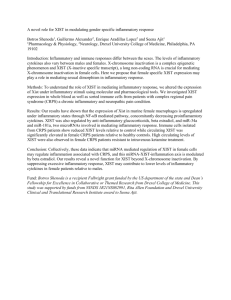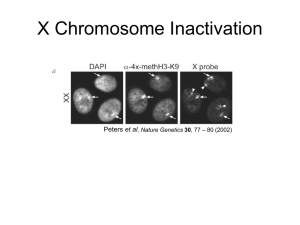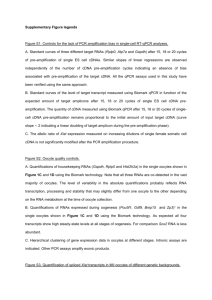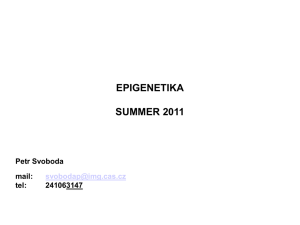Spatial partitioning of the regulatory landscape of the X
advertisement
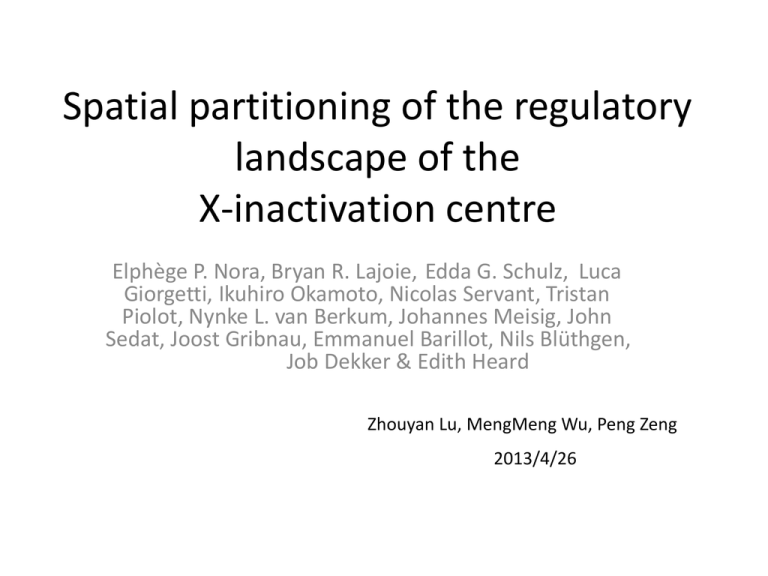
Spatial partitioning of the regulatory landscape of the X-inactivation centre Elphège P. Nora, Bryan R. Lajoie, Edda G. Schulz, Luca Giorgetti, Ikuhiro Okamoto, Nicolas Servant, Tristan Piolot, Nynke L. van Berkum, Johannes Meisig, John Sedat, Joost Gribnau, Emmanuel Barillot, Nils Blüthgen, Job Dekker & Edith Heard Zhouyan Lu, MengMeng Wu, Peng Zeng 2013/4/26 X-chromosome inactivation (XCI) • X-inactivation is a process by which one of the two copies of the X chromosome present in female mammals is inactivated. • The X-inactive specific transcript (Xist) gene encodes a large non-coding RNA that is responsible for mediating the specific silencing of the X chromosome from which it is transcribed. X-inactivation centre (Xic) • Contains Xist ,its repressive antisense transcript Tsix and the regulator of Tsix, Xite, and many other elements. • Xic is thought to affect choice, counting and cis-inactivation during the initiation of X inactivation Spatial partitioning • Analysed the spatial organization of a 4.5megabases (Mb) region including Xist. • Discovered a series of discrete 200-kilobase to 1 Mb topologically associating domains (TADs) on this region. Methods • chromosome conformation capture carboncopy (5C) • fluorescent in situ hybridization (FISH) Topologically associating domains • 5C2 analysis in undifferentiated mouse embryonic stem cells (ESCs) • Long-range ( >50 kb) contacts preferentially occur within a series of discrete genomic blocks. 3D DNA FISH Whether the size and location of these TADs is identical… …in male and female mouse ESCs? …during differentiation? …during XCI? What might drive chromatin folding in TADs? • H3K27me3 and H3K9me2 Lack H3K27me3 Lack H3K9me2 Whether folding in TADs is driven by boundary elements at their borders? Summary • The partitioning is stable throughout differentiation, X inactivation and in cell lines with impaired histone-modifying machineries. • TAD boundaries can have a critical role in highorder chromatin folding but still remain further investigating. What's the relationship between TADs and gene expression? • The gene expression within the same domain have higher correlation. • downregulated : TAD D,F • upregulated : TAD E • Jpx,Ftx,Xpr,Rnf12 from TAD E are positive regulators to Xist, which can be intergrated into a similar cis-regulatory network. • Predict that TAD E(~550k) represents minimum 5' regulatory region for Xist expression, which maybe the reason why transgenes tested so far(covering 150kb 5' to Xist) can't recapitulate Xist expression. • Xist promoter and positive regulators are located in TAD E. • Tsix promoter located in TAD D, in addition to Xite enhancer, more distant elements within TAD D may regulate Tsix. • Tg53: covering TAD D • Tg80:just covering Xite • some elements within TAD D regulate Tsix Summary • TAD have significant correlation with gene expression. • TAD can help us to discover gene expression pattern. • TAD can help us to discover gene regulation elements. Significant looping events involving the Tsix promoter or its enhancer Xite Peak-calling of chromosomal looping events at Xist, Tsix and the Xite enhancer Chromatin signatures of enhancers Enhancer signatures in the Xist/Tsix region Linx identification a transcript initiating approximately 50 kb upstream of the Ppnx promoter Linx identification a transcript initiating approximately 50 kb upstream of the Ppnx promoter Linx RNA shares several features with non-coding RNAs, such as accumulation around its transcription site, nuclear enrichment and abundance of the unspliced form. Linx and Tsix are co-expressed in the inner cell mass of blastocysts from E3.5–4.0 onwards, as well as in male and female mouse ESCs. Linx RNA is not detected earlier in embryogenesis, nor in extra-embryonic lineages, implying an epiblast-specific function. Linx expression is frequently monoallelic, even before Xistupregulation, revealing a transcriptional asymmetry of the two Xic alleles before XCI Triple RNA FISH for Linx, Tsix and Xist in differentiating female mouse ESCs revealed that before Xist upregulation, the probability of Tsixexpression from alleles coexpressing Linx is significantly higher than from alleles that do not express Linx. Triple RNA FISH for Linx, Tsix and Xist in differentiating female mouse ESCs revealed that before Xist upregulation, the probability of Tsixexpression from alleles coexpressing Linx is significantly higher than from alleles that do not express Linx. Discussion



